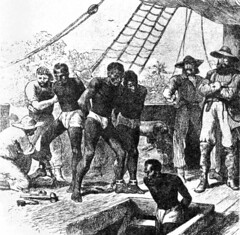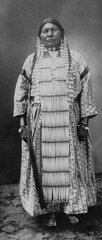AMSCO AP US History Chapter 1 Flashcards
AMSCO United States History 2015 Edition, Chapter 1 A New World of Many Cultures, 1491-1607
Terms : Hide Images [1]
| 7427985725 | corn | The Mayas and the Incas cultivated it as an important stable food supply. (p. 2) |  | 0 |
| 7427985726 | horses | It was not until the 17th century that the American Indians acquired these animals from the Spanish. (p. 4) |  | 1 |
| 7427985727 | disease | When Europeans came to America they brought smallpox and measles to which the natives had no resistance. Millions of American Indians died from these diseases. (p. 8) |  | 2 |
| 7427985728 | encomienda system | King of Spain gave grants of land and natives (as slaves) to individual Spaniards. (p. 8) |  | 3 |
| 7427985729 | asiento system | This system required that a tax be paid to the King of Spain, for slaves that were imported to the Americas. (p. 8) |  | 4 |
| 7427985730 | slavery | As far back as the 1500s the Spanish brought captured Africans to America to provide free labor. (p. 11) |  | 5 |
| 7427985731 | land bridge | Some time between 10,000 and 40,000 years ago, people migrated from Asia to the Americas, across this area that connected Siberia and Alaska. (p. 2) |  | 6 |
| 7427985732 | Adena-Hopewell | This American Indian culture centered in Ohio created large earthen mounds as tall as 300 feet. (p. 4) |  | 7 |
| 7427985733 | Hokokam, Anasazi, and Pueblos | These American Indians were located in the New Mexico and Arizona region. They developed farming using irrigation systems. (p. 4) |  | 8 |
| 7427985734 | Woodland mound builders | American Indian tribe east of the Mississippi that prospered because of a rich food supply. (p. 4) |  | 9 |
| 7427985735 | Lakota Sioux | American Indian tribe that started using horses in the 17th century. This allowed them to change from farming to nomadic buffalo hunting. (p. 4) |  | 10 |
| 7427985736 | Mayas | From A.D. 300 to 800, this highly developed civilization built large cities in what is today's southern Mexico and Guatemala. (p. 2) |  | 11 |
| 7427985737 | Incas | This highly developed civilization developed a vast South American empire based in Peru. (p. 2) |  | 12 |
| 7427985738 | Aztecs | Starting about 1300, this civilization flourished in central Mexico. (p. 2) |  | 13 |
| 7427985739 | conquistadores | These Spanish explorers and conquerors of the Americas sent ships loaded with gold and silver back to Spain making it the richest and most powerful nation in Europe. (p. 8) |  | 14 |
| 7427985740 | Hernan Cortes | He conquered the Aztecs in Mexico. (p. 8) |  | 15 |
| 7427985741 | Native Americans | The first people to settle North America arrived as many as 40,000 years ago. They came from Asia and may have crossed by a land bridge connecting Siberia and Alaska. (p. 1) |  | 16 |
| 7427985742 | Francisco Pizarro | He conquered the Incas in Peru. (p. 8) |  | 17 |
| 7427985743 | New Laws of 1542 | Bartolome de Las Casas convinced the King of Spain to institute these laws, which ended American Indian slavery, ended forced Indian labor, and began the process of ending the encomienda systems. (p. 11) |  | 18 |
| 7427985744 | Roanoke Island | In 1587, Sir Walter Raleigh attempted to establish a settlement here, but it failed. (p. 9) |  | 19 |
| 7427985745 | compass | One aspect of the Renaissance was a gradual increase in scientific knowledge and technological change. Europeans made improvements in the inventions of others. this invention was used in sailing. (p. 5) |  | 20 |
| 7427985746 | printing press | This invention in the 1450s spread knowledge across Europe. (p 5) |  | 21 |
| 7427985747 | Ferdinand and Isabella | They united Spain, defeated and drove out the Moors. In 1492, they funded Christopher Columbus's voyage to America. (p. 5) |  | 22 |
| 7427985748 | Protestant Reformation | In the early 1500s, certain Christians in Germany, England, France, Holland, and other northern European countries revolted against the authority of the pope in Rome. (p. 6) |  | 23 |
| 7427985749 | Henry the Navigator | The monarch of Portugal. (p. 7) |  | 24 |
| 7427985750 | Christopher Columbus | He spent 8 years seeking financial support for his plan to sail west from Europe to the "Indies". In 1492, he sailed from the Canary Islands to an island in the Bahamas. His success in discovering lands on the other side of the ocean brought him a burst of glory in Spain. (p. 7) |  | 25 |
| 7427985751 | Treaty of Tordesillas (1494) | In 1494, this treaty between Spain and Portugal, moved the line of demarcation that the pope had established a few degrees to the west. (p. 8) |  | 26 |
| 7427985752 | slave trade | Since ancient times people in Europe, Africa, and Asia had enslaved pepoe captured in wars. In the 15 century the Portuguese began trading for slaves from West Africa. They used slaves to work in sugar plantation off the coast of Africa. Using slaves was so profitable that when the Europeans settled in the Americas, they instituted the slave system there. (p, 6) |  | 27 |
| 7427985753 | nation-state | In the 15th century, small kingdoms and multiethnic empires were being replaced by nation-states. Nation-states were countries in which the majority of people shared a common culture and common loyalty toward a central government. (p. 6) |  | 28 |
| 7427985754 | Algonquian | The American Indians had 20 language families and 400 distinct languages. This tribe in the Northeast was one of the largest. (p. 4) |  | 29 |
| 7427985755 | Siouan | The American Indians had 20 language families and 400 distinct languages. This tribe from the Great Plains was one of the largest. (p. 4) |  | 30 |
| 7427985756 | Iroquois Confederation | A political union of five independent American Indian tribes in the Mohawk Valley of New York. (p. 5) |  | 31 |
| 7427985757 | longhouses | American Indians along the Pacific Coast lived in the these plank houses. (p. 4) |  | 32 |
| 7427985758 | John Cabot | An Italian sea captain who sailed under contract to England's King Henry VII. He explored the coast of Newfoundland in 1497. (p. 9) |  | 33 |
| 7427985759 | Jacques Cartier | In the period for 1534 to 1542, he explored the St. Lawrence River. (p. 10) |  | 34 |
| 7427985760 | Samuel de Champlain | He established the first permanent French settlement at Quebec, a fortified village on the St. Lawrence River. (p., 10) |  | 35 |
| 7427985761 | Henry Hudson | This English sailer was hired by the Dutch government to seek a westward passage to Asia through North America. In 1609, while searching for the passage, he sailed up a broad river that would later be named the Hudson River. (p 10) |  | 36 |
| 7427985762 | Bartolome de Las Casa | A Spanish priest who was an advocate for better treatment of Indians. (p. 11) |  | 37 |
| 7427985763 | Valladolid Debate | In 1550-1551, in Valladolid, Spain, a formal debate concerning the role of American Indians in the Spanish colonies. (p. 11) |  | 38 |
| 7427985764 | Juan Gines de Sepulveda | In the Valladolid Debate, this Spaniard argued that the American Indians were less than human. (p. 11) |  | 39 |
